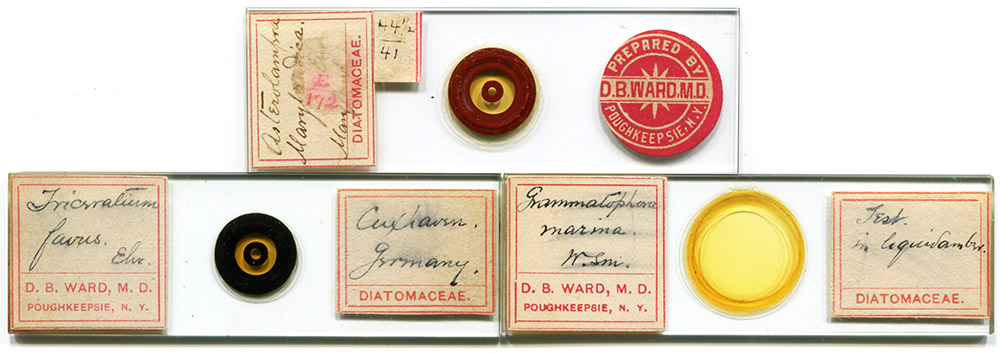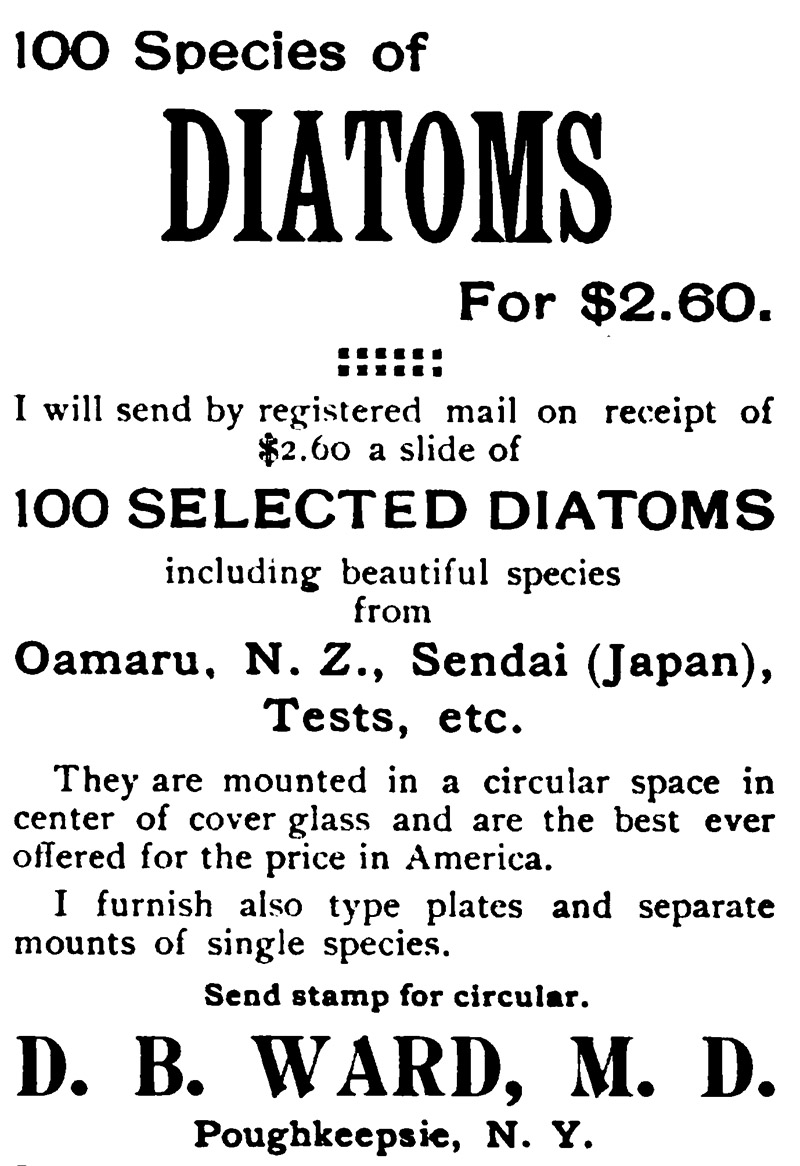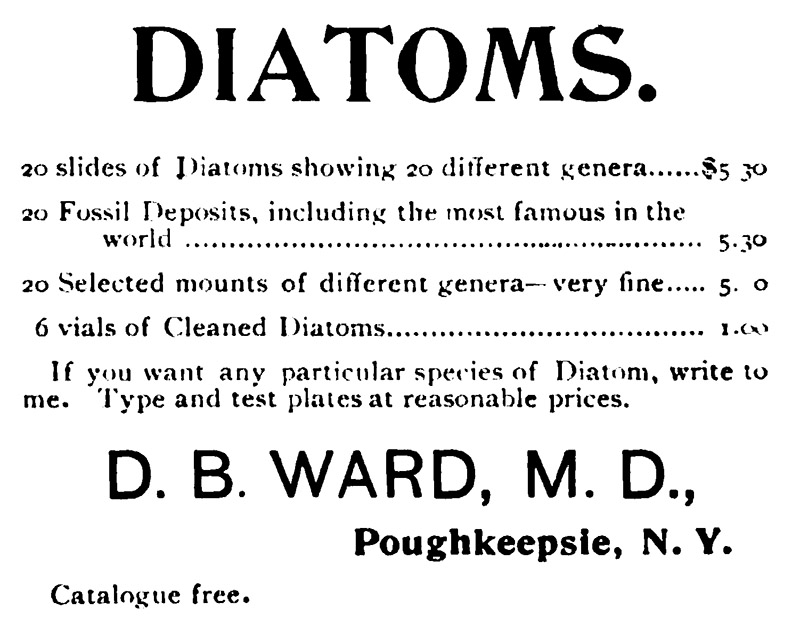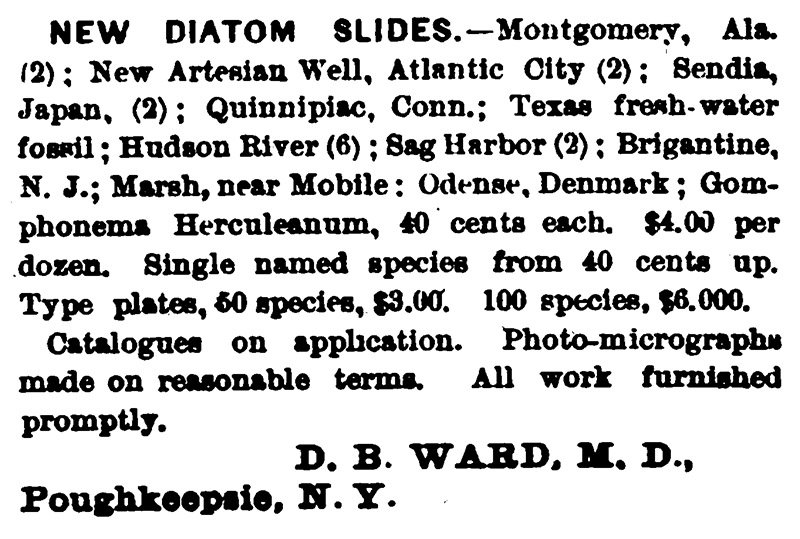
Figure 1. Microscope slides by D.B. Ward. Known advertisements indicate that Ward produced slides for sale or exchange between 1889 and 1895.
David Boyd Ward, 1853-1907
by Brian Stevenson
last updated January, 2019
D.B. Ward, M.D., was a physician in Poughkeepsie, New York, USA, and an expert in identifying and mounting diatoms. He began advertising commercial sales of mounted diatoms in late 1890, although had been advertising to exchange his slides for at least a year before that. Those 1889 exchange offers were for “slides of selected diatoms”, indicating that he already possessed the skills necessary for picking out and mounting individual diatom frustules, and suggesting that he had then been working with diatoms for several years. Ward offered both pre-made slides, and custom mounts from his clients’ gatherings. He also provided photomicrographs of diatoms, and identified species in gatherings on request. I located exchange offers and sales advertisements through the middle of the 1890s, ending in 1895.

Figure 1.
Microscope slides by D.B. Ward. Known advertisements indicate that Ward produced slides for sale or exchange between 1889 and 1895.
David Ward was born in Poughkeepsie on March 13, 1853, the first of three children. His father, Alson, was a banker. David received his medical degree in 1879 from the New York College of Physicians and Surgeons (now part of Columbia University). He then returned to his parents’ home and took up medical practice.
Ward presumably learned to use a microscope in medical school, if not earlier. The origin of his expertise in diatoms is not known. He was a recognized expert by the late 1880s, both as a microscopist and as a photographer. For example, Lewis Woolman’s 1889 paper on “Geology of artesian wells at Atlantic City, N.J.” thanked “Dr. D.B. Ward of Poughkeepsie, N. Y., for photo-micrographs of (diatoms) which have aided the author in their study”.
Offers to exchange slides of selected diatoms appeared by 1889, and sales advertisements were published by December, 1890. Both advertisements and exchange requests for new material were frequently published for several years thereafter.
A good salesman, Ward received journalistic goodwill in return for giving samples to editors. For example, this note from The Microscope, 1891, “To Dr. D.B. Ward, Poughkeepsie, N. Y., for three superb slides of Diatoms: Aulacodiscus Rogersii from Barnegat, N.J., Coscinodiscus subtilis from the Hudson river, and Anthodiscus floreatus from Oamaru, N.Z. The Diatoms are mounted on the cover and surrounded by a little ring of cement so that the microscopist can find them with no loss of time. The Aulacodiscus is perfection, even to the three or four marginal apparently tubular processes, their presence unbroken being an evidence of great care and skill in the manipulation”.
This editor’s note appeared in The Observer, 1894, “We are under obligations to Dr. D.B. Ward, of Poughkeepsie, N.Y., for a slide each of diatoms from the localities between Essex and Manchester, Mass., and Alhambra, Cal., the same being prepared from the earths distributed by The Observer in November and January last. Dr. Ward is one of The Observer's subscribers, and as such, receives the club material. We find that there are many readers of The Observer who are interested in the original descriptions given of the diatomaceous material distributed, but who, from lack of time or ability, cannot prepare mounts of this material. Dr. Ward, at our request, has consented to mount slides of the various earths offered and described, and will furnish ‘strewed’ mounts for about thirty cents each. Dr. Ward's entry in his private catalogue concerning the contents of the Alhambra slides will be of general interest. “Alhambra, Cal., fossil, marine. Coscinodiscus marginatus var. subsubmarginata; (predominant); Actinoptychus undulasus; Stictodiscus Californicus; Coscinodiscus radiatus, robustus, and subtilis; Antinocyclus incerte; Euodia gibba; Cocconcis nitida, etc.” The material contains a good variety of species, and Dr. Ward regards it as very like the Redondo Beach earth. We are also indebted to Dr. Ward for a print of the odontophore of Buccinum undatum distributed in January, and a fine photograph of an abnormal form Arachnoidiscus ornatus, occurring in the Alhambra earth. Speaking of this abnormal form, Dr. Ward adds, ‘is very singular fact that this genus, Arachnoidiscus, and the neighboring genus, Stictodiscus, are very much given to monstrosities of this kind. I have quite a collection of them, some looking as if they were struck by lighting’.”
A Postal Microscopical Club was begun in the U.S. in the mid-1890s. Similar to that of the U.K., the club mailed boxes of slides to subscribers, who had a period of time to examine the specimens, then post the them on to the next member on a list. A published description on the first box of 1894 included, “Slide No. 1, by M.A. Booth, is a well known object, the wing of a mosquito. Few have seen it in such perfection as here. It is a marvel of delicate manipulation, almost every scale on the edge of the wing being in situ. There is also attached a fine photo-micrograph by Dr. D.B. Ward, which is so beautifully clear that one has no need of a microscope for this slide”.
In 1894 and 1895, Ward presented lectures to the nearby Vassar Brothers Institute, on “Diatoms” and “Bacteria”. Soon afterward, he became the Poughkeepsie City Bacteriologist, responsible for assessing purity of drinking water and other sanitation controls. A published study on water quality in Poughkeepsie included this remark, “In 1895 eight bacteriological examinations were made by D.B. Ward, M.D., of Poughkeepsie, from April to December”. Another noted, “After 1897 specimens of water, filtered and unfiltered, were sent to Dr. David B. Ward, who was then the only bacteriologist here, and one of the best of his time”.
I have not located any advertisements for slide sales by Ward after 1895. It may be that his duties as City Bacteriologist did not allow sufficient time for that side business, or it may be that he no longer needed the supplemental income.
His 1907 death was announced in The Journal of the American Medical Association, “David B. Ward, M.D. College of Physicians and Surgeons, New York, 1876; city bacteriologist, Poughkeepsie, N.Y., died at his home in that city, January 24, after an illness of a few days, aged 53”.
Ward’s personal collection of diatoms was acquired by Robert Hagelstein (1870-1945), who later donated it to the New York Botanical Gardens. Slides from Ward’s collection, possibly coming from the Hagelstein collection, are occasionally seen in private collections.

Figure 2.
An 1889 exchange offer from D.B. Ward. From “The American Monthly Microscopical Journal”.

Figure 3.
1891-92 advertisements, from “The Microscope”.

Figure 4.
An 1892 advertisement, from “The Observer”.

Figure 5.
An 1893 advertisement, from “The American Monthly Microscopical Journal”.

Figure 6.
An 1895 advertisement, from “The Observer”.

Figure 7.
An 1895 advertisement, from “The American Monthly Microscopical Journal”.
Resources
The American Monthly Microscopical Journal (1889) Exchange offers from D.B. Ward, Vol. 10, numerous issues
The American Monthly Microscopical Journal (1891) Exchange offers from D.B. Ward, Vol. 12, numerous issues
The American Monthly Microscopical Journal (1893) Advertisements from D.B. Ward, Vol. 14, numerous issues
The American Monthly Microscopical Journal (1895) Advertisements from D.B. Ward, Vol. 16, numerous issues
Fowler Charles E. (1898) The operation of a slow sand filter, Journal of the New England Water Works Association, Vol. 12, pages 209-244
Grave headstone of D.B. Ward, “born March 13, 1853, died January 24, 1907, aged 53”, https://www.findagrave.com/memorial/154709728
The Journal of the American Medical Association (1907) Note on the death of D.B. Ward, Vol. 48, page 540
The Microscope (1890) Advertisement from D.B. Ward, Vol. 10, December issue only
The Microscope (1891) Advertisements from D.B. Ward, Vol. 11, numerous issues
The Microscope (1891) Editor’s acknowledgements to D.B. Ward, Vol. 11, pages 24 and 218
The Observer (1892) Advertisements from D.B. Ward, Vol. 3, numerous issues
The Observer (1894) Editor’s acknowledgements to D.B. Ward, Vol. 5, pages 122, 158, 284, and 347
The Observer (1895) Advertisements from D.B. Ward, Vol. 6, numerous issues
Officers and Graduates of Columbia University (1916) “Graduates in Medicine … David Boyd Ward, A.B. 73, Hamilton Coll., A.M. 76,. d. 1907”
Sylvester, W.H. (1894) Notes on the Postal Club, The Observer, Vol. 5, page 177
Transactions of the Medical Society of the State of New York (1888) “Medical Society of the County of Dutchess … Members … D.B. Ward, Poughkeepsie”, pages 618-619
Transactions of the Medical Society of the State of New York (1904) “Medical Society of the County of Dutchess … D.B. Ward, Treasurer”, page 443
U.S. census and other government records, accessed through ancestry.com
Ward, D.B. (1894) An experience with the action of media on cells, The Observer, Vol. 5, pages 178-179
Ward, D.B. (1894) Diatoms, Transactions of Vassar Brothers Institute, and its Scientific Section, Vol. 6, pages 66-85
Ward, D.B. (1895) Bacteria, Transactions of Vassar Brothers Institute, and its Scientific Section, Vol. 6, pages 125-205
Ward, Henry B. (1896) A Biological Examination of Lake Michigan in the Traverse Bay Region, page 75
Woolman, Lewis (1889) Geology of artesian wells at Atlantic City, N.J., The American Monthly Microscopical Journal, Vol. 10, page 132
Year Book of the Dutchess County Historical Society (1942) page 69